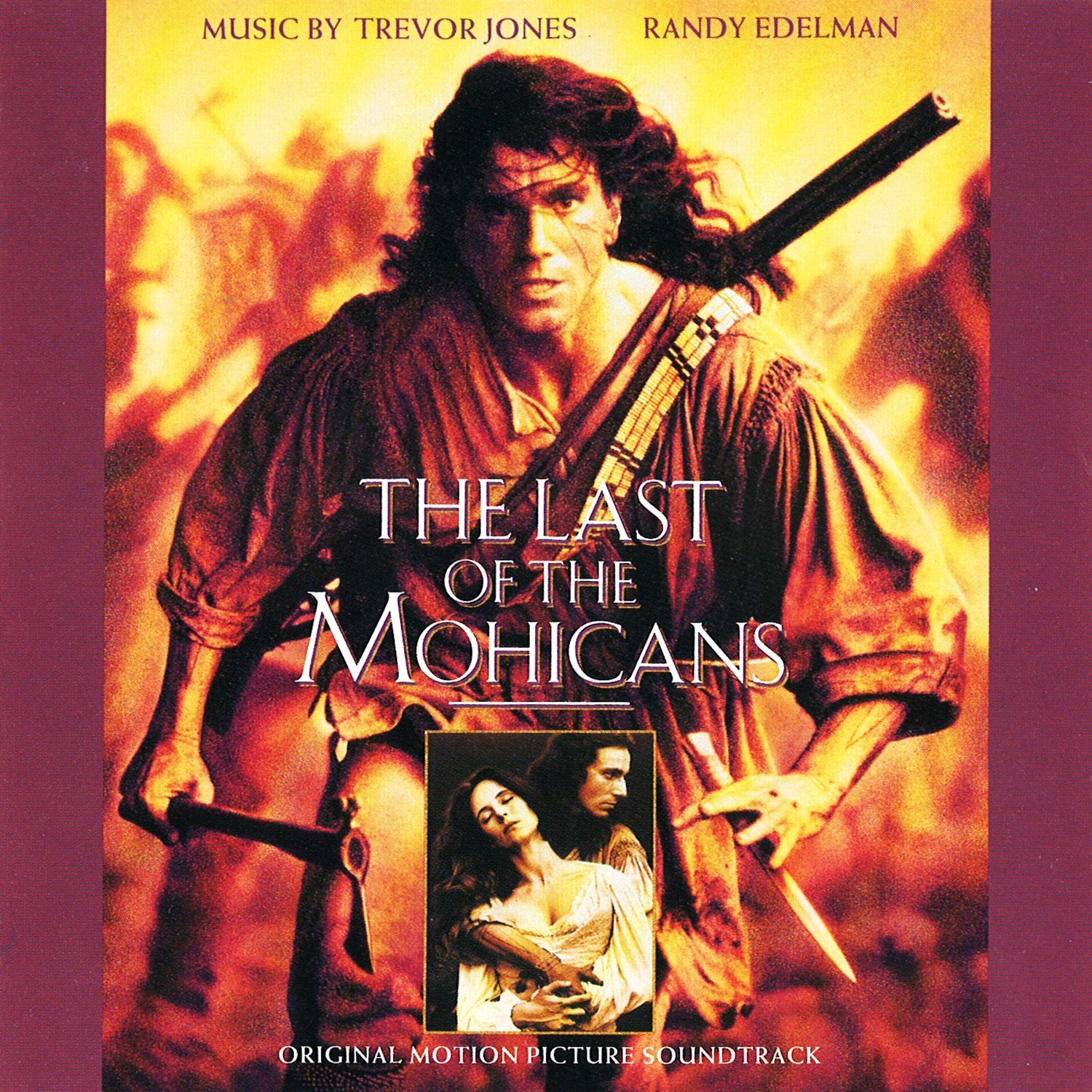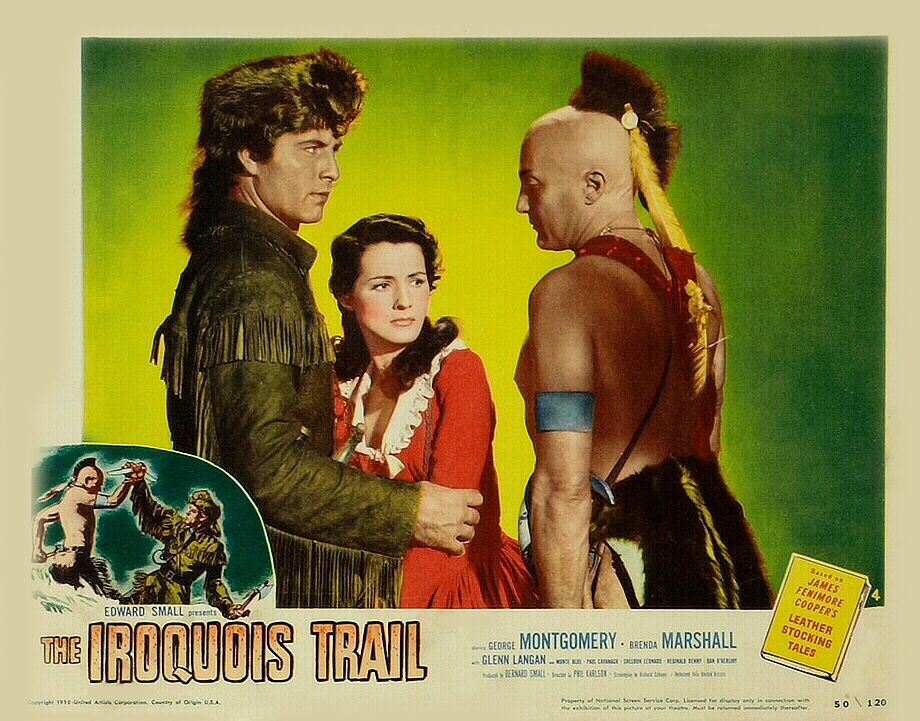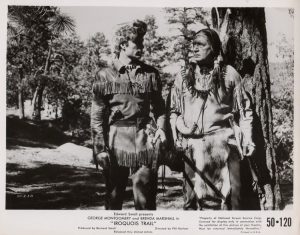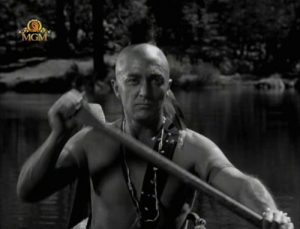In the 1992 movie “The Last of the Mohicans,” filmmaker Michael Mann found inspiration in the famous but dreadful novel by James Fenimore Cooper. As did the folks who made “The Iroquois Trail,” forty years before, Mann and his crew took what they wanted from the source material in an effort to construct an adventurous story that spoke to a large white audience. The film one one hand sheds some light on the broad cultural influence of the Onondaga Nation and Americans’ changing attitudes toward Native American peoples in the late 1980s and early 1990s. It also demonstrates how limited that change really was.
In Mann’s “Mohicans,” as in Cooper’s novel, native people are either noble or ignoble, all uniquely in touch with their surroundings and with nature, but all tragic, all doomed. They appear, they do things, but clearly they will all disappear. Cooper’s novel and Mann’s film both reflect long-held notions of the “Vanishing American.” In 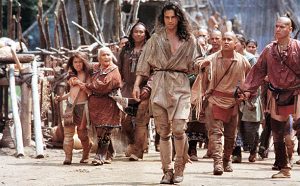 the original novel, Natty Bumppo, or Hawkeye, along with his companions Chingachgook and Uncas escort the daughters of the British colonel Munro, Alice and Cora, through the war-scarred wilderness as they avoid the vengeful Huron Magua. Cora, the daughter of Munro and an African slave, draws the attention of both Uncas and Magua, but Alice, whose name means “Light,” does not. Cora, darker of skin and hair, is pursued by Cooper’s “dusky” characters, and makes statements more sympathetic to native peoples than do other characters in the novel. She dies in a Huron attack, but Alice does not.
the original novel, Natty Bumppo, or Hawkeye, along with his companions Chingachgook and Uncas escort the daughters of the British colonel Munro, Alice and Cora, through the war-scarred wilderness as they avoid the vengeful Huron Magua. Cora, the daughter of Munro and an African slave, draws the attention of both Uncas and Magua, but Alice, whose name means “Light,” does not. Cora, darker of skin and hair, is pursued by Cooper’s “dusky” characters, and makes statements more sympathetic to native peoples than do other characters in the novel. She dies in a Huron attack, but Alice does not.
Mann did not address Cora’s race, and it is hair-haired Alice who draws the attention of the Indians in his version of the story. In Manning’s hands, “Mohicans” is a love story, with Cora and Hawkeye (renamed in this film Nathaniel Poe because, well, Natty Bumppo is a stupid name) occupying center stage. Alice, rather than fall into savage hands, flings herself over a cliff and dies.
“Last of the Mohicans” came out during my third year of graduate school in 1992. It was the sort of film that grad students in Early American history loved to criticize and laugh at. Indeed, I always remembered the film most for its famous goofs and careless film-maker’s blunders. The English leave Fort William Henry after its surrender to the French: Where will they go? Why they will march towards the two large buses visible in the shot. How will they get there? The director with the blue baseball cap and the bullhorn will tell them where to go. Danger awaits, however, as Magua’s warriors prepare to spring the trap, the right-handed warriors on one side, the left on the other.
Mann’s film appeared two years after Kevin Costner’s “Dances With Wolves” set a new standard for Native American involvement in movies about native peoples. It also appeared a month before the 500th anniversary of Columbus’s “discovery” of America. The Columbian Quincentenary provoked scholars and activists alike to look once again at the catastrophic consequences of European discovery. Popular books like Kirkpatrick Sale’s The Conquest of Paradise and David Stannard’s American Holocaust appeared, as well as special editions of scholarly journals like the William and Mary Quarterly examining the legacies of the “Columbian Encounter.” Publishers produced books for young readers providing more sympathetic treatment of native subjects.
Americans’ attitudes toward native peoples had changed, it seemed, and manifestations of this appeared all over: from the growing interest among early American historians in Native American history, for instance, to a large number of films and documentaries. Anthropologists and historians began to tell each other, even if they did not always act on their own advice, that they ought to talk to the Native American descendants of those about whom they wrote and whose histories and cultures they researched. In 1987, under the influence of a small group of scholars in Native American Studies, the United States Senate passed a resolution acknowledging Native American contributions to American democracy, even if historians roundly criticized the “Iroquois Influence” thesis. There seemed to be an increasing amount of interest in native peoples.
Filmmakers like Michael Mann were of course not immune to these changes. For his film to succeed, he needed the support and participation of native peoples. Otherwise, it would be viewed as neither authentic nor acceptable.
Mann shot the film in North Carolina, a far-cry from the story’s setting in northern New York, largely on land surrounding the opulent Biltmore estate. Large numbers of Cherokees served as extras. Mann brought in actors from across Native America. And because Onondaga remained in many ways a “Capital City” in Native America, and its leaders spoke with such authority on so many issues, Mann sought their advice and their assistance. According to a story that appeared in the Syracuse Post-Standard on August 15, 1992, “more than a dozen Onondagas, including two chiefs and a clan mother, appear in this Hollywood version of Jame Fenimore Cooper’s tale of the upstate frontier.” Thadodaho Leon Shenandoah appeared in the film, as did Clan Mother Alice Papineau. Dennis Banks, the great American Indian Movement leader who spent time as a fugitive at Onondaga, also appeared in the film. The shooting took place over several weeks. Onondagas received eighty dollars a day, plus room, board, and transportation. It was tiring. When the shooting ended, “sound technicians returned to Onondaga to tape voices of Indian men and women and the laughter of children.” Leon Shenandoah told the paper that “the movie’s waterfall sounds echo the falls that spill over Hemlock Creek on the reservation.” Yet despite the hard work, those Onondagas involved in the movie looked forward to seeing the finished product.
“All the more wonder, then,” the Post-Standard reported six weeks later, “why 20th Century Fox paid little attention to upstate New York and its Iroquois nations when debuting ‘The Last of the Mohicans” in Syracuse. The film’s producers invited nearly 400 people to a special screening at the Fayetteville Mall but only fifteen were Onondagas, “most of whom scored tickets late in the day.” According to the story, “Lynn LaRocca, the Syracuse representative of several Hollywood studios, including 20th Century Fox, said the studio sought a low-key opening but did not ignore the movie’s upstate ties.” LaRocca told reporters that she mailed complementary tickets to Leon Shenandoah, but he “was out of town and unable to pick them up at an off-reservation post office box.” Though some were able to get their hands on tickets, most in the community would have to wait to see the movie and pay the price of admission.
Those Onondagas who did see the film at its premiere had positive things to say. Vincent Johnson “praised the film’s insightful depiction of Colonial America, one that showed Indians and early colonists sharing similar problems with the European powers.” He told the reporter that “It’s nice to see Real Native Americans in a movie.”
Michael Mann and the film’s producers needed Indians in the film. They needed cooperation and assistance for reasons tied solely to the movie’s bottom line. But they really did not want any interference or trouble. Show up. Do what we ask you to do. Let us make our movie. Collect your paychecks and then disappear. The inattention the producers paid to the Onondagas at the movie’s premier shows clearly the limits of their respect. They liked Indians best when they allowed them to create a fictionalized representation of the American past, a movie that became even more than Cooper’s novel, a story of white people falling in love.
A long time ago I used to assign Fergus Bordewich’s Killing the White Man’s Indian to students in my Native American survey course. It was the first book we read. Bordewich argued that both native peoples and white people embraced certain standards and definitions of who Indians were and what they ought to be that were extremely limiting. One part of this was to cast native peoples as part of the past. Mann and his crew wanted native peoples to play parts in his film, to accept their role in the story he wanted to tell quietly and without complaint. In this sense, Mann was not unlike many, many historians who have done the same thing. Indians existed, in Turner’s language, at the “outer edge of the wave,” and the “meeting point of savagery and civilization.” If they showed up anywhere else, in any other manner, they were a problem that could be cast aside, ignored, forgotten.

